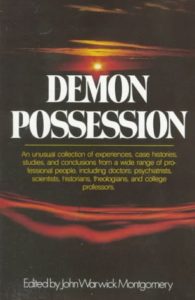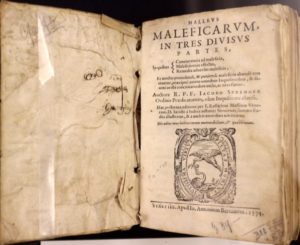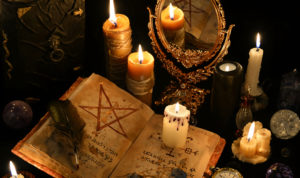Oct
28
Witchcraft and Satanism in the Middle Ages through 20th Century
“Now the Spirit explicitly says that in later times some will depart from the faith, paying attention to deceitful spirits and the teachings of demons, through the hypocrisy of liars whose consciences are seared.” — I Tim. 4:1-2 (HCSB)
 On January 8-11, 1975, an invitation-only symposium was hosted by the Christian Medical Society on the campus of the University of Notre Dame. The topic was “the Phenomena Labeled as ‘Demonic’.” The participants consisted of doctors, psychiatrists, scientists, historians, theologians, and professors, all of whom were committed to the historic, biblical, evangelical Christian faith. Many of them had had personal experience with the paranormal, the occult, and demonic; those whose experience in this area was limited to documented accounts of others “found their own beliefs intensified and broadened by personal narratives….”
On January 8-11, 1975, an invitation-only symposium was hosted by the Christian Medical Society on the campus of the University of Notre Dame. The topic was “the Phenomena Labeled as ‘Demonic’.” The participants consisted of doctors, psychiatrists, scientists, historians, theologians, and professors, all of whom were committed to the historic, biblical, evangelical Christian faith. Many of them had had personal experience with the paranormal, the occult, and demonic; those whose experience in this area was limited to documented accounts of others “found their own beliefs intensified and broadened by personal narratives….”
The following year, Bethany House published a collection of the “experiences, case histories, studies, and conclusions” presented at the symposium under the title Demon Possession, edited by one of the contributors, the brilliant John Warwick Montgomery. I only recently picked up a copy, but as I was leafing through it, I found an interesting section I thought I might share with you this All Hallows’ Eve season. It is from the chapter titled “The Occult Revival in Historical Perspective” by Richard Lovelace (ThD, Princeton), then Associate Professor (and later Professor Emeritus) of Church History at Gordon-Conwell Theological Seminary. It’s just a portion of the chapter and thus a mere snapshot of the contents of the book, but I think many of you will find it interesting.
—
“This brings us to the forms of the occult which I have designated as hard-core, witchcraft and Satanism. There are two main theories of the historical origins of witchcraft: that of Margaret Murray, who in 1921 proposed the thesis that witchcraft in Western Europe was only a survival of the pre-Christian pagan worship of the male Horned God and female goddess akin to Ashtaroth and Diana; and the strongly opposing thesis of Montague Summers, a Roman Catholic scholar, who insists that the witches were self-conscious worshippers of the devil, who signed blood pacts with him and had all the characteristic features which their Christian inquisitors attributed to them. Summers took the occult powers of the witches quite seriously, and vigorously attacked Miss Murray’s contention that they were innocuous followers of a nature cult. We shall see that both Miss Murray and Summers are supported by evidence within the modern witchcraft movements.
 Summers contends that the forerunners of witches were abhorrent even to respectable pagans. He notes that in 721 B.C. the ruling Roman triumvirate banished all astrologers and charmers, and that later Maecenas called on Augustus to exile sorcerers and magicians as despisers of the gods, which set a precedent for similar action by Tiberius, Claudius, and Vespasian. Charles Williams comments that the motivation for the pagan attack on witchcraft was primarily the desire to eliminate all possible centers of political disaffection, as in the parallel instance of the persecution of Christians. Williams notes that the early church adopted an ambivalent attitude toward witchcraft, on the one hand attacking it as a powerless superstition, and on the other, trying to eradicate it as if it were a plague. He might have added that as the Middle Ages developed, popular Catholicism incorporated many elements which are suspiciously similar in form, including the practice of candle-burning before saints and the elevation of the Virgin Mary to a position practically equivalent to that of the female deity in the typical bitheistic pairing noted by Miss Murray.
Summers contends that the forerunners of witches were abhorrent even to respectable pagans. He notes that in 721 B.C. the ruling Roman triumvirate banished all astrologers and charmers, and that later Maecenas called on Augustus to exile sorcerers and magicians as despisers of the gods, which set a precedent for similar action by Tiberius, Claudius, and Vespasian. Charles Williams comments that the motivation for the pagan attack on witchcraft was primarily the desire to eliminate all possible centers of political disaffection, as in the parallel instance of the persecution of Christians. Williams notes that the early church adopted an ambivalent attitude toward witchcraft, on the one hand attacking it as a powerless superstition, and on the other, trying to eradicate it as if it were a plague. He might have added that as the Middle Ages developed, popular Catholicism incorporated many elements which are suspiciously similar in form, including the practice of candle-burning before saints and the elevation of the Virgin Mary to a position practically equivalent to that of the female deity in the typical bitheistic pairing noted by Miss Murray.
As the medieval period developed, uneasiness about the powers of darkness among Christians and occult interest among the populace seem to have increased. Summers associates a concurrent expansion of witchcraft with the appearance of heretical gnostic sects like the Bogomils, Paulicians, and Albigenses around the turn of the millennium, and feels that there is a connection between gnosticism and witchcraft. In an able and fascinating article in Church History, Donald Nugent observes that the first great flowering of witchcraft during the Christian Era occurred during the Renaissance. In 1258, Pope Alexander IV directed a bull to the Franciscan Inquisitors initiating the attack in 1484, and in 1490 the Jesuits Heinrich Kramer and James Sprenger produced their classic Christian manual on witchcraft, the Malleus Maleficarum. Apparently the numerical high point of the witchcraft explosion occurred just before and during the Protestant Reformation. By 1700, somewhere between thirty thousand and several millions of witches had been tried and executed. [Note: I believe this estimate has been greatly reduced based on more recent scholarship.] The Reformation, however, launched a biblical attack on magical elements in contemporary Christian practice, and on the occult world outside the church, which began to restrain the world of superstition. The eighteenth-century Enlightenment further reduced the incidence of sorcery, to such an extent that even the existence of professing witches became an article of doubt. Nevertheless there continued to be an underground stream of witchcraft and Satanism during the eighteenth and nineteenth centuries. Peter Gay, who contends that the Enlightenment itself was a neo-Pagan revival, notes that in the left wing of the movement, among libertines such as the Marquis de Sade, sexual magic and a semi-serious demonalatry were practiced in places like the Hellfire Caves of France and England.
In the late nineteenth century the stream begins to surface quietly, first in the rather respectable and domesticated magic of A.E. Waite’s Order of the Golden Dawn and then in the virulent Satanism of Aleister Crowley. J.K. Huysmans’ novel La-Bàs indicates the existence of similar movements in France. C.S. Lewis comments that he was aware of, and attracted to, several circles of magical interest in London during the 1920’s and 30’s. According to Margaret Murray’s thesis, the work of Gerald Gardner, an anthropologist and practicing warlock, disseminated a form of witchcraft in the 1930’s and 40’s in England. After the repeal of the Witch Act in Britain in 1951, English witchcraft began to proliferate openly, and in the 1960’s Sybil Leek and other articulate exponents rose into prominent view in the media, conducting a skillful public relations campaign to advance the image of Wicca, the “old knowledge,” as they preferred to call their religion.
 The inertial momentum of the post-Enlightenment disbelief in witchcraft was still sufficiently strong, however, that scholars of the caliber of E.E. Evans-Pritchard, Pennethorne Hughes, and H.R. Trevor-Roper continued concurrently to assert the nonexistence of witchcraft. In the late 1960’s the media were presenting so much evidence of a witchcraft revival that this kind of scholarly ignorance became increasingly difficult.
The inertial momentum of the post-Enlightenment disbelief in witchcraft was still sufficiently strong, however, that scholars of the caliber of E.E. Evans-Pritchard, Pennethorne Hughes, and H.R. Trevor-Roper continued concurrently to assert the nonexistence of witchcraft. In the late 1960’s the media were presenting so much evidence of a witchcraft revival that this kind of scholarly ignorance became increasingly difficult.
In 1967 a group of hippies surrounded the Pentagon and conducted an exorcism. In 1968, on Halloween, WITCH — the Women’s International Terrorist Conspiracy from Hell — held a demonstration. In England, reports of grave robberies began to appear, and Anglican and Catholic clergy found themselves reviving the practice of exorcism in desecrated churches. There were ritual murders in New Jersey and California, and the supreme horror of the Manson murder case. There were rumors that the Rolling Stones dedicated their performances to Satan. Alice Cooper changed his name to that of one of the witches executed at Salem at the direction of a ouija board. [Note: Cooper is now a born-again, evangelical Christian.] And rock acts appeared which seemed to have more in mind than publicity in their occult references, such as Arthur Brown and Black Sabbath. In 1971 Newsweek estimated that there were some 80,000 white witches in America. Time‘s cover story in 1972 noted that one airline was offering a “psychic tour of Britain” for $629, and estimated that somewhere between three and seven million Germans were involved seriously in the occult. Writing in His Magazine in 1970, Robert Evans of the Greater Europe Mission stated that there were more warlocks in Germany than Protestant pastors, and more in France than the number of doctors. He noted also the existence of a school for witches in Ulting, England. This kind of institution seems to exist also in a number of American cities.
Just as in the case of the counterculture and the Jesus movement, the media are quieter now about witchcraft. But in each of these instances the silence may be simply existing because the phenomenon in question has become a normal and accepted part of the current landscape, not because it has receded or vanished. The serious witchcraft movement in America today is as organized and vigorous in its growth as evangelical Christianity. It has its own publishing houses — more than half a dozen of them — producing books with titles like The Caldron Cookbook, The Stock Market and Witchcraft, Sexual Power through Witchcraft, and even children’s books which beautify the witch’s image. There is even a journal called the Occult Trade Review, which is not surprising since the movement generates a multi-million-dollar industry. Witchcraft has its own travelling evangelists, chief among them Sybil Leek, Hans Holzer, and Martin Ebon. There are also resident spokespersons who act as pastors and bishops in different locales. In my own area, a young woman named Laurie Cabot who runs a witchcraft shop and has styled herself “The Witch of Salem” gives lectures to local PTA’s, and is establishing an occult institute to train disciples on the North Shore. Hans Holzer has written an instructive vade mecum which tours the major cities in American and lists the varieties of witchcraft available in their covens, which include Sicilian, Welsh, Druidic, Haitian, and many others.
 Some covens practice black or malefic witchcraft, attempting to raise the “cone of power” to destroy their enemies — and there are wars among the witches, according to Holzer. The established exponents of witchcraft are publicly critical of black witchcraft; it gives the craft a bad name. Some covens practice sexual magic in the Gardnerian tradition, initiating new members in the “Great Rite,” an act of ceremonial intercourse. Some, like California’s Feraferia, seem as elfin and innocuous as a Tolkien story. The most significant common feature of all these covens is the worship of a duad of gods, one male and one female. It appears that Margaret Murray’s theory is borne out of the surviving remnants of the witch cults, unless these have been consciously modelled after her thesis. Modern witchcraft is a revival of the pagan pattern represented by the worship of Baal and Ashtaroth.
Some covens practice black or malefic witchcraft, attempting to raise the “cone of power” to destroy their enemies — and there are wars among the witches, according to Holzer. The established exponents of witchcraft are publicly critical of black witchcraft; it gives the craft a bad name. Some covens practice sexual magic in the Gardnerian tradition, initiating new members in the “Great Rite,” an act of ceremonial intercourse. Some, like California’s Feraferia, seem as elfin and innocuous as a Tolkien story. The most significant common feature of all these covens is the worship of a duad of gods, one male and one female. It appears that Margaret Murray’s theory is borne out of the surviving remnants of the witch cults, unless these have been consciously modelled after her thesis. Modern witchcraft is a revival of the pagan pattern represented by the worship of Baal and Ashtaroth.
This does not mean that Montague Summers’ thesis is not equally supported by some data. Aleister Crowley, the son of Plymouth Brethren parents, concluded after a reading of the book of Revelation that he was the Great Beast predicted in it, and devoted the rest of his life to acts of sexual magic attempting to beget the Antichrist, under the direction of a discarnate entity named Aiwaz. He is apparently the figure on whom Roman Castavet, in Rosemary’s Baby, is based. There is little doubt that Crowley was an intentional Satanist.
Anton LaVey’s Church of Satan in California, on the other hand, seems to be a collection of basically agnostic swingers using Nietzschean philosophy as an excuse for hedonism.”
—
Naturally, I’m curious how things may have changed and what insights Dr. Lovelace may have from the past 40+ years of occultic influence in Western society. (I should note that I edited out a few sentences at the end about one purported ex-Satanist, many of whose claims were debunked years later.) But, I am not aware of any follow-ups to this symposium or the book in question. Still, it was an interesting survey, and I look forward to reading the rest of the chapter, not to mention the rest of the book. Hope I didn’t creep anyone out with the subject matter, but I think studies like this are helpful for separating fact from fiction and getting an historical perspective. Given Lovelace’s title for his paper/chapter, I’m guessing that was his intent.
















